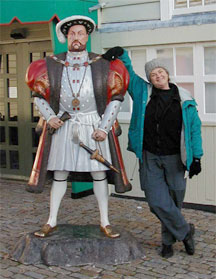 Boys as young as twelve served onboard, as well as convicts and pressed gangs (men kidnapped from British coastal towns). There was nothing romantic about the seafaring life back then.
Boys as young as twelve served onboard, as well as convicts and pressed gangs (men kidnapped from British coastal towns). There was nothing romantic about the seafaring life back then.
Holiday Greetings to All of You,
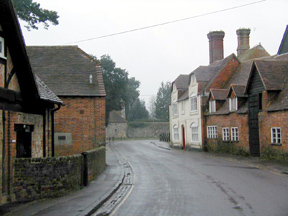
Our last week of travel was spent seeing the southeast part of England, called the Channel and Downs. From London, we drove down to the New Forest, land bordering the ocean and across from the Isle of Wight. Both of us had read “The New Forest” by Rutherford which describes an area that was royal hunting ground for centuries. It is now an interesting mix of very small medieval villages, ancient oak-beech forest, and moors (heather fields). Horses, donkeys, and cows run free, while residents have to fence in anything they don’t want munched upon. The animals are very used to people. Despite making a variety of noises, Tim could barely get a smile out of one roadside horse for a photograph.
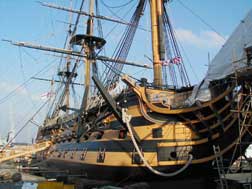
Traveling along the southern coast, we came to Portsmouth, a major maritime city. We spent most of a day in the historic dockyard. One highlight was an onboard tour of the HMS Victory. This is the flagship Vice-Admiral Horatio Nelson used to win the Battle of Trafalgar in 1805 against a combined French and Spanish fleet (He died during the battle). Much of the ship has been meticulously restored over the years, so we could see how cannons were fired (noisy); the living conditions of the men (good for officers, lousy for others), the food (moldy), and medical care onboard (no anesthetics). An interesting fact was that the lower you went in the ship, the lower the ceilings were.
 Boys as young as twelve served onboard, as well as convicts and pressed gangs (men kidnapped from British coastal towns). There was nothing romantic about the seafaring life back then.
Boys as young as twelve served onboard, as well as convicts and pressed gangs (men kidnapped from British coastal towns). There was nothing romantic about the seafaring life back then.
We also saw the HMS Mary Rose. This ship was built under King Henry VIII, sailed for several decades, and sunk in the shallow waters of Portsmouth Harbor in 1545 as Henry watched (it was overloaded). Twenty years ago, the remains of the hull were brought up from the sea bottom along with thousands of well-preserved artifacts. These included everything from swords and guns to leather shoes and book covers to jewelry and gold, giving us some further information on how the Tudors lived. The ship itself is held in an enclosed dry dock and is being sprayed with a chemical solution that will eventually replace all the water in the wood, allowing it to be displayed openly later. The size and condition of the ship after all this time in the water is pretty amazing.
Next stop, Brighton, the premier beach destination for centuries of Britons. Just off the ocean pier is one of the strangest buildings we’ve ever seen, the Royal Pavilion. The future King George IV was the Prince of Wales during the early 19th century.
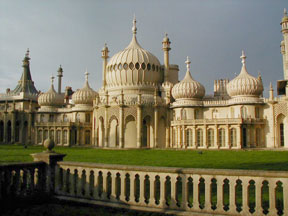 While his father King George III (of American Revolution infamy) ruled, this boy George spent all the time he could avoiding government and parents. He created the Pavilion as a place to party with friends, take “health-improving” dips in the sea, and cavort with his numerous ladies. The huge, white Pavilion looks a royal palace from India complete with minarets. The inside is completely decorated with what the British thought Chinese interior design should look like (not always accurately). It is opulent (bordering on garish) but fascinating. What we thought would be an hour or so of touring took half a day. The people of Brighton welcomed George and company because they (like present-day tourists) spent money in town. The rest of the country thought George a fool and a squanderer, showing their displeasure in wonderful political cartoons (which were displayed in the Palace). Brighton was also, for us, the location of the worst hostel we’ve had.
While his father King George III (of American Revolution infamy) ruled, this boy George spent all the time he could avoiding government and parents. He created the Pavilion as a place to party with friends, take “health-improving” dips in the sea, and cavort with his numerous ladies. The huge, white Pavilion looks a royal palace from India complete with minarets. The inside is completely decorated with what the British thought Chinese interior design should look like (not always accurately). It is opulent (bordering on garish) but fascinating. What we thought would be an hour or so of touring took half a day. The people of Brighton welcomed George and company because they (like present-day tourists) spent money in town. The rest of the country thought George a fool and a squanderer, showing their displeasure in wonderful political cartoons (which were displayed in the Palace). Brighton was also, for us, the location of the worst hostel we’ve had.
For those of you unfamiliar with hostels, there are basically two types. The International Youth Hostels (YHA) and independent hostels. YHA hostels are found worldwide and we try to stay in them as they are usually smoke-free, clean and well-maintained. There are always exceptions, of course, but through the YHA we have stayed at castles, mansions, modern urban settings, and old houses in medieval cities.
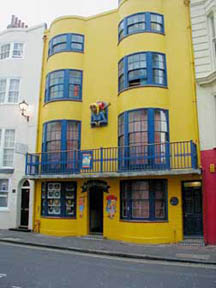 We stay in family rooms, meaning that there could be a double or twin beds (even a bunk or two), but we are alone in the room. Sometimes we are lucky enough to get our own bathroom, sometimes not. When Tim and I (separately) went to Europe after college, we stayed in YHA dorm rooms of 4 to 12 people. We are too old (and carrying too much luggage) for that now.
We stay in family rooms, meaning that there could be a double or twin beds (even a bunk or two), but we are alone in the room. Sometimes we are lucky enough to get our own bathroom, sometimes not. When Tim and I (separately) went to Europe after college, we stayed in YHA dorm rooms of 4 to 12 people. We are too old (and carrying too much luggage) for that now.
The independent hostels vary widely in quality. Most allow smoking in certain areas which usually permeates to the bedrooms. Also, these are the home of the pancake pillows, the size of a pillow with the thickness of a pancake. Some independent hostels have been delights, like the hostel in Malen Head with a peat fire and home-grown organic vegetables available. Brighton Backpackers, on the other hand, was a small hole in the wall (I mean, a small room with holes in the walls). You reached the room by narrow stairs and halls. The plumbing was marginal and there were bare wires (dead, we hoped) along the walls. The nearest fire escape was the room next door which led to an area completely surrounded by buildings. In case of fire, there was no real escape. This is the only place we stayed where I reread the emergency instructions every night before I went to sleep. Sometimes, staying in a place that is convenient and cheap has its drawbacks.
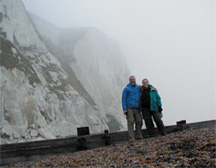
The white cliffs of Dover, according to the postcards, are a line of stark white chalk cliffs bordering the English Channel. As we approached Dover in a fog (the weather, not us), there wasn’t much to see. We cut down a side road which ended at the water. There we were, at the base of one of the cliffs. We still couldn’t see far, but we were able to walk along the bottom of the cliff. It really is made of chalk, like the kind we used on blackboards. The cliffside also contained caves and had areas covered with vegetation, usually not seen in photographs. We were also the only people there, one of the major advantages in traveling mid-December. Since both of us had only seen the cliffs from the channel ferry years ago, this experience was a real treat.
Our last stop before returning to London was Canterbury. We stayed at a B&B converted from a fifteenth century abbey gatehouse. The B&B was just a half block from the town center with its narrow streets, cathedral, and pilgrim hospital.
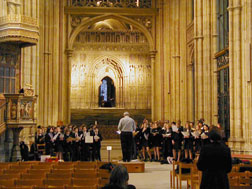 The cathedral was nearly empty when we visited it one morning. Since we are cheapskates, we had skipped the paid tour. To our good fortune, a guide came up to us, asked us if we had any questions, then took us on a personal tour of the cathedral and its crypt (basement). When he had to leave, he asked his colleague to continue the tour. The second gentleman was a stained glass window aficionado and gave us wonderful detailed explanations of the meanings of the numerous windows (both ancient and modern). This is the cathedral where Thomas Beckett was murdered by four noblemen in the twelfth century. Since then it has been an international destination for religious pilgrimages. The movies “Beckett” and “Murder in the Cathedral” are based on the murder. Money left by the pilgrims helped to expand the cathedral. We were fortunate enough to attend the Christmas choral concert of a local high school in the cathedral. The young voices filled the air and resounded off of the ancient walls.
The cathedral was nearly empty when we visited it one morning. Since we are cheapskates, we had skipped the paid tour. To our good fortune, a guide came up to us, asked us if we had any questions, then took us on a personal tour of the cathedral and its crypt (basement). When he had to leave, he asked his colleague to continue the tour. The second gentleman was a stained glass window aficionado and gave us wonderful detailed explanations of the meanings of the numerous windows (both ancient and modern). This is the cathedral where Thomas Beckett was murdered by four noblemen in the twelfth century. Since then it has been an international destination for religious pilgrimages. The movies “Beckett” and “Murder in the Cathedral” are based on the murder. Money left by the pilgrims helped to expand the cathedral. We were fortunate enough to attend the Christmas choral concert of a local high school in the cathedral. The young voices filled the air and resounded off of the ancient walls.
The pilgrim hospital was built soon after Beckett’s murder to house poor pilgrims coming to the cathedral. It was more a hostel than hospital; travelers were given food and lodging for one night then sent on their way. It is still used to house the poor. Chaucer’s poem “The Canterbury Tales” were the stories of such pilgrims traveling to Beckett’s shrine. I will have to reread the poem (last read, somewhat reluctantly, in high school) with more enthusiasm, I think.
We arrived in London to do some last minute errands. On route we stopped at the Victoria and Albert Museum, a huge place that specializes in the decorative arts like textiles, jewelry, china, glass, and interior design.
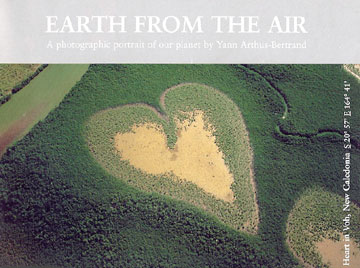 Two special displays showed the history of furniture and that of glass, which complimented what we had seen in other museums. Next door at the Natural History Museum was an outdoor gallery, containing over 100 photos, each about 4 by 6 feet. They were scenes from the book “Earth from the Air” a series of unbelievable aerial photographs. Many of them were geographical or geological patterns that were art in its own right like the eye-shaped Yellowstone Lake, or a patchwork pattern of dates drying in the Middle East. Check out this book if you can.
Two special displays showed the history of furniture and that of glass, which complimented what we had seen in other museums. Next door at the Natural History Museum was an outdoor gallery, containing over 100 photos, each about 4 by 6 feet. They were scenes from the book “Earth from the Air” a series of unbelievable aerial photographs. Many of them were geographical or geological patterns that were art in its own right like the eye-shaped Yellowstone Lake, or a patchwork pattern of dates drying in the Middle East. Check out this book if you can.
The last day of the trip was spent doing the Tate Museum of Modern Art from top to bottom. Neither of us is art experts, to say the least. But, while we saw works by many established masters (like Dali and Picasso) and some talented more recent artists, there were also a lot of works in which we saw no artistic value. My sister Michele, an artist, might understand them more, but a cube made of bricks just doesn’t excite us. We ended the day with an organ recital at Westminster Abbey. We joined a small group of people listening to a variety of works that took full advantage of the numerous pipes and the huge cathedral. The music swirled around us and, quite frankly, the animated finale left me breathless.
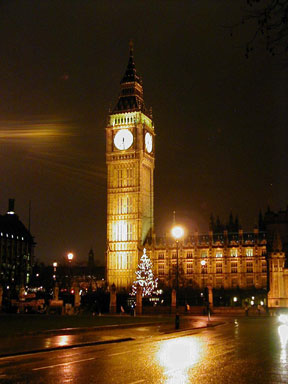 As we walked home to the tube, we passed Big Ben with a lit Christmas tree in front (see attached photo). We realize how fortunate we were to be able to make this visit to Britain and Ireland.
As we walked home to the tube, we passed Big Ben with a lit Christmas tree in front (see attached photo). We realize how fortunate we were to be able to make this visit to Britain and Ireland.
As in all trips, we find things and experiences we will miss (and try to reconstruct if we can): tea breaks, Fanta lemon soda, friendly people with amusing accents, mountains and cathedrals, shortbread, oatcakes (Di only on that), old Tudor buildings, stone circles, and organic chocolate/orange bars.
We won’t miss: pervasive smoking, English high fat and high cholesterol breakfasts, mushy peas, tasteless sausages and hot dogs, the dismal dollar/pound exchange rate, English toilet paper (it isn’t Charmin), driving on other side of the road, and 17.5% VAT tax.
Thanks to our families and coworkers for making this all possible. And thanks to you for reading. May your holidays be joyful and may the New Year bring peace to all of us.
Di and Tim
| Page Top |
Map |
Itinerary |
Last |
|
| Tim and Diane's email address is ttdk@aol.com | ||||